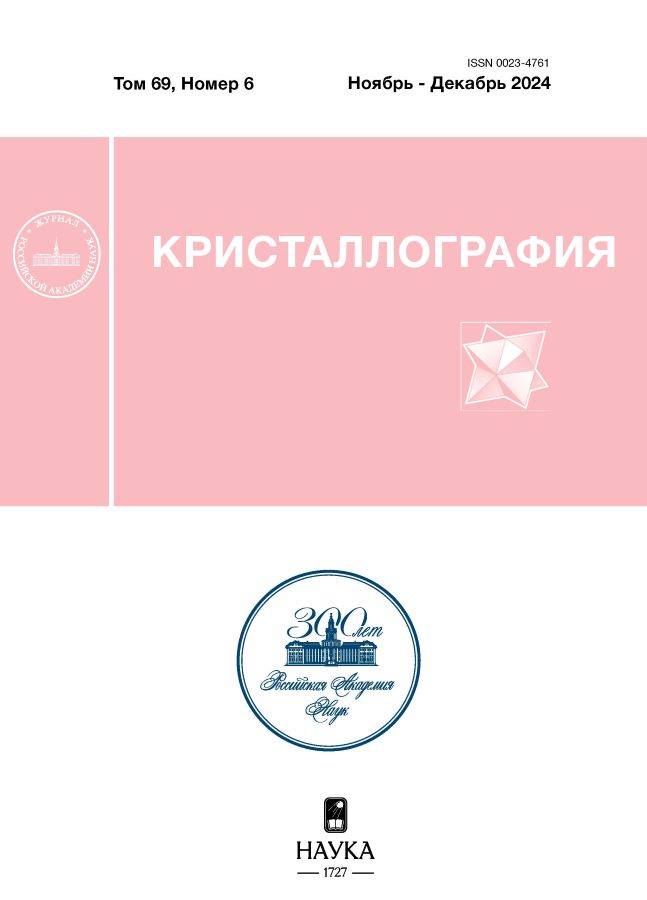Atomistic simulation of paratellurite α-teo2 crystal: i. Defects and ionic transport
- Autores: Ivanov-Schitz A.K.1
-
Afiliações:
- Shubnikov Institute of Crystallography of Kurchatov Complex of Crystallography and Photonics of NRC “Kurchatov Institute”
- Edição: Volume 69, Nº 6 (2024)
- Páginas: 1009-1017
- Seção: ФИЗИЧЕСКИЕ СВОЙСТВА КРИСТАЛЛОВ
- URL: https://permmedjournal.ru/0023-4761/article/view/673630
- DOI: https://doi.org/10.31857/S0023476124060116
- EDN: https://elibrary.ru/YGWVEB
- ID: 673630
Citar
Texto integral
Resumo
The structure and defects of α-TeO2 paratellurite crystals have been studied using computer modeling. It has been shown that in α-TeO2 the preferred point defects are oxygen vacancies and interstitial oxygen ions. Oxygen vacancies can be either isolated or form complex clusters. It is energetically most favorable for interstitial oxygen ions to be located in channels that penetrate the paratellurite structure along the c-axis. The origin of possible oxygen–ion transport in α-TeO2 is discussed.
Texto integral
Sobre autores
A. Ivanov-Schitz
Shubnikov Institute of Crystallography of Kurchatov Complex of Crystallography and Photonics of NRC “Kurchatov Institute”
Autor responsável pela correspondência
Email: alexey.k.ivanov@gmail.com
Rússia, Moscow
Bibliografia
- Кондратюк И.П., Мурадян Л.А., Писаревский Ю.В. и др. // Кристаллография. 1987. Т. 32. С. 609.
- Thomas P.A. // J. Phys. C. 1988. V. 21. P. 4611. http://stacks.iop.org/0022-3719/21/i=25/a=009
- Дудка А.П., Головина Т.Г., Константинова А.Ф. // Кристаллография. 2019. Т. 64. С. 930. https://doi.org/10.1134/S0023476119060043
- Ceriotti M., Pietrucci F., Bernasconi M. // Phys. Rev. B. 2006. V. 73. P. 104304. https://doi.org/10.1103/PhysRevB.73.104304
- Champarnaud-Mesjard J.C., Blanchandin S., Thomas P. et al. // J. Phys. Chem. Solids. 2000. V. 61. P. 1499. https://doi.org/10.1016/S0022-3697(00)00012-3
- Малютин С.А., Саплавская К.К., Карапетьянц М.Х. // Журн. неорган. химии. 1971. Т. 16. С. 781.
- Deringer V.L., Stoffel R.P., Dronskowski R. // Cryst. Growth Des. 2014. V. 14. P. 871. http://doi.org/10.1021/cg401822g
- Uchida N., Ohmachi Y. // J. Appl. Phys. 1969. V. 40. P. 4692. https://doi.org/10.1063/1.1657275
- Arlt G., Schweppe H. // Solid State Commun. 1968. V. 6. P. 783. https://
- Gupta N., Voloshinov V. // Opt. Lett. 2005. V. 30. P. 985. https://doi.org/10.1364/OL.30.000985
- Wang P., Zhang Z. // Appl. Opt. 2017. V. 56. P. 1647. https://doi.org/10.1364/AO.56.001647
- El-Mallawany R.A.H. Tellurite Glasses Handbook: Physical Properties and Data; CRC Press: Boca Raton, FL, 2002.
- Li Y., Fan W., Sun H. et al. // J. Appl. Phys. 2010. V. 107. P. 093506. https://doi.org/10.1063/1.3406135
- Liu Z., Yamazaki T., Shen Y. et al. // Appl. Phys. Lett. 2007. V. 90. P. 173119. https://doi.org/10.1063/1.2732818
- Ковальчук М.В., Благов А.Е., Куликов А.Г. и др. // Кристаллография. 2014. Т. 59. С. 950.
- Куликов А.Г. // Образование приповерхностных структур в кристаллах парателлурита и тетрабората лития при миграции носителей заряда во внешнем электрическом поле. Дис. … канд. физ.-мат. наук. Москва. 2019.
- Dick B.G., Overhauser A.W. // Phys. Rev. 1958. V. 112. P. 90.
- Torzuoli L., Bouzid A., Thomas P., Masson O. // Mater. Res. Express. 2020. V. 7. P. 015202. https://doi.org/10.1088/2053-1591/ab6128
- Mayo S.L., Olafson B.D., Goddard W.A. // J. Phys. Chem. 1990. V. 94. P. 8897. http://dx.doi.org/10.1021/j100389a010
- Gulenko A., Masson O., Berghout A. et al. // Phys. Chem. Chem. Phys. 2014. V. 16. P. 14150. https://doi.org/10.1039/c4cp01273a
- Achouri M.M., Ziani N., Bouamrane R., Abderrahmane A. // Indian J. Phys. 2018. V. 92. P. 1373. https://doi.org/10.1007/s12648-018-1232-2
- Gale J.D., Rohl A.L. // Mol. Simul. 2003. V. 29. P. 291. http://dx.doi.org/10.1080/ 0892702031000104887
- Mott N.F., Littleton M.J. // Trans. Faraday Soc. 1932. V. 34. P. 485.
- Smith W., Todorov I.T., Leslie M. // Z. Kristallogr. 2005. B. 220. S. 563. https://doi.org/10.1524/zkri.220.5.563.65076
- Silvestrova I.M., Pisarevskii Y.V, Senycshenkov P.A. et al. // Phys. Status Solidi. А. 1987. V. 101. P. 437. https://doi.org/10.1002/pssa.2211010215
- Ledbetter H., Leisure R.G., Migliori A. et al. // J. Appl. Phys. 2004. V. 96. P. 6201. https://doi.org/10.1063/1.1805717
- Ohmachi Y., Uchida N. // J. Appl. Phys. 1970. V. 41. P. 2307. https://doi.org/10.1063/1.1659223
- Jain H., Nowick A.S. // Phys. Status Solidi. А. 1981. V. 67. P. 701. https://doi.org/10.1002/pssa.2210670242
- Mezaki R., Margrave J.L. // J. Phys. Chem. 1962. V. 62. P. 66. https://doi.org/10.1021/j100815a037
- Pashinkin A.S., Rabinovich I.B., Sheiman M.S. et al. // J. Chem. Thermodynamics. 1985. V. 17. P. 43. https://doi.org/10.1016/0021-9614(85)90030-8
- Wegener J., Kanert О., Küchler R. et al. // Z. Naturforsch. А. 1994. B. 49. S. 1151. https://doi.org/10.1515/zna-1994-1208
- Wegener J., Kanert O., Küchler R. et al. // Rad. Eff. Defects Solids. 1995. V. 114. P. 277.
- Hartmann E., Kovács L. // Phys. Status Solidi. А. 1982. V. 74. P. 59. https://doi.org/10.1002/pssa.2210740105
Arquivos suplementares
Arquivos suplementares
Ação
1.
JATS XML
2.
Fig. 1. Crystal structure of α-TeO2: in the (bc) plane (a), in the (ab) plane (b). O1…O4, Te1…Te4 are the atomic numbers, d1, d2 are the Te–O bonds. In Fig. (b), the letter A marks the “square” through channels that penetrate the structure along the c axis.
Baixar (101KB)
3.
Fig. 2. RPCF of ideal α-TeO2 at a temperature of 300 K, the numbers on the curves indicate the maxima of the corresponding RPCF peaks for the first and second coordination spheres (a); 1 – calculation at 900 K, 2 – calculation at 1200 K (b).
Baixar (133KB)
4.
Fig. 3. RPCF of paratellurite at 300 K for an ideal crystal (1) and a sample with 15 oxygen vacancies (2).
Baixar (88KB)
5.
Fig. 4. RPCF of defective paratellurite with five interstitial oxygen atoms in type A channels at temperatures of 300 (1) and 1100 K (2).
Baixar (86KB)
6.
Fig. 5. Lattice parameters of TeO2 with different degrees of defectiveness in the temperature range of 1100–1500 K: 1 – stoichiometric composition, 2 – five oxygen vacancies, 3 – 10 interstitial oxygen atoms, 4 – 15 oxygen vacancies.
Baixar (92KB)
7.
Fig. 6. Temperature dependences of oxygen diffusion coefficients for TeO2 with different degrees of defectiveness: 1 – five oxygen vacancies, 2 – 15 oxygen vacancies, 3 – five interstitial oxygen ions, 4 – 10 interstitial oxygen ions, 5 – five tellurium vacancies. The numbers near the straight lines are the diffusion activation energies.
Baixar (80KB)















